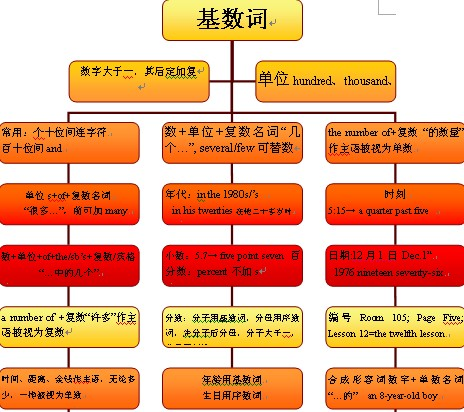本试题 “In________, he began to learn Russian, when he was in________.[ ]A. 1970; the 50'sB. the 1970; his 50sC. the 1970s; his fiftiesD. 1970s; his fifties” 主要考查您对基数词
物主代词
等考点的理解。关于这些考点您可以点击下面的选项卡查看详细档案。
- 基数词
- 物主代词
基数词的概念:
数词是指表示数目多少或顺序先后的词。表示数目多少的数词叫基数词,如one, five, ten, thirty, sixty-five等,数词与不定代词用法相似,在现代英语中,它与不定代词、冠词、指示代词、形容词性物主代词等被称之为限定词。数词用法相当于名词和形容词,在句中可用作主语、宾语、表语、定语、同位语等。
时刻的表示法:
①若为整点钟,则直接读相应的基数词;若为非整点钟,则分别以“时”和“分”为单位用相应的基数词读出:
如:twelve (12),
eight twenty (8:20),
nine forty-five (9:45)
②对于带“分”的时间,也可借助past(过)和to(差)这两个介词来表示(在美国英语中用after表示“过”)。
注:这样表示时“分”不能超过30,否则应作处理,如9.38应处理成“10点差22分”:
如:9.18 eighteen minutes past(after)nine(=nine eighteen)
10.46 fourteen minutes to eleven(=ten forty-six)
以上分钟后带了minutes一词。若“分”为5,10,15,20等五的倍数,则可省略minutes:
如:8.05 five(minutes)past[after]eight(=eight five)
9.20 twenty(minutes)past[after]nine(=nine twenty) 若“分”为15或45,可借用quarter一词;若“分”为30,可借用half一词:
如:6.15 a quarter past six
8.45 a quarter to nine
10.30 half past ten
注:时刻表示法分为12小时编时制和24小时编时制。
日期的表示法:
日期的写法(书面语)和读法(口语)稍有不同,如“十月一日”可以写成October1, October 1st, 1October, 1st October, (the)1st of October 等,表示月份的词也可用缩略式,如Oct.1, 1Oct.1,但是在口语中通常只有两种读法October(the)first或the first of October。
注:日期与星期排列时,通常是星期在前,日期在后:
如:He arrived on Friday, May10. 他于5月10日(星期五)到达。
年份的表示法:
通常以“百”为单位来读。如1986年通常读作nineteen(hundredand)eighty-six,除非在正式场合,其中的hundred and通常都省,但在通常情况下不能按普通基数词的读法那样读成one thousand nine hundred and eighty-six。不过,像1500这样的年份可以有两种读法one thousand five hundred和fifteen hundred,而2000年通常读作two thousand,2003年读作two thousand and three。若表示某个某个年代,则按类似以下的读法:1980s读作nineteen-eighties(20世纪80年代),1600s读作sixteen hundreds(17世纪头10年,即1600—1610),比较:1300 thirteen hundred(1300年)。
基数词的表示法:
(1)以下是最基本的基数词:
one(1), two(2), three(3), four(4), five(5), six(6), seven(7), eight(8), nine(9), ten(10),
eleven(11), twelve(12), thirteen(13), fourteen(14), fifteen(15), sixteen(16), seventeen(17), eighteen(18), nineteen(19),
twenty(20), thirty(30), forty(40), fifty(50), sixty(60), seventy(70), eighty(80), ninety(90), a hundred(100), a thousand(1000), a million(1000000), a billion(十亿)
(2)21—99的表示法。先说“几十”,再说“几”,中间加连字号:
如:twenty-one(21),
thirty-six(36),
forty-five(45),
ninety-nine(99)等。
(3)101—999的表示法。先说“几百”,后接and,再加末尾两位数(或末位数):
如:one hundred and one(101),
five hundred and thirty(530),
seventy hundred and eighty-nine(789)
(4)1000以上的基数词的表示法。先从右至左数,每三位数加一个逗号(即以此把数目分为若干段)。
第一个逗号前的数为thousand(千),第二个逗号前的数million(百万),第三个逗号前的数为billion(十亿),第四个逗号前的数为trillion(万亿),然后一段一段地数:
如:9,883 nine thousand, eigh thundred and eighty-three
65,359 sixty-five thousand, three hundred and fifty-nine
265,468 two hundred and sixty-five thousand, four hundred and sixty-eight
60,263,150 sixty million, two hundred and sixty-three thousand,one hundred and fifty
注:①英语没有“万”这个单位,要表示“万”须借用thousand,如“一万”用“十千”表示(ten thousand),“十万”用“百千”表示(one hundred thousand)。
②hundred, thousand, million, billion等词在读数时不带复数词尾-s(即用单数形式)。
③在hundred后通常加上连词,不过此and在美国英语中可以省略。若读数中没有hundred,则在thousand后加and。
④一个数的最高位若为“一”,这个“一”可用a或one表示,但在数字中间的“一”,则只能用one,不能用a:
如:1600a[one]thousand and six hundred
6100 six thousand and one hundred (其中的one不可改为a)
⑤在非正式场合,人们也常以hundred为单位来读数
如:It cost fifteen hundred pounds. 这东西花了1500英镑。
基数词知识体系:

用于复数形式的基数词:
(1)表示整十的基数词用复数形式可以表示人的岁数或年代:
如:in the sixties 在60年代
in one's thirties 在某人30多岁时
(2)基数词转化为名词,可用复数形式:
如:How many twos are there in ten? 10里面有几个2?
Thesoldiersmarchedintens.士兵们10人一排前进。
(3)某些习语中也用复数形式的基数词:
如:in[by] twos and threes 三三两两地
at sixes and sevens 乱其八糟
表示倍数的基数词:
1、倍数+as +形容词/副词(原级)+ as+比较对象。
如: 这座桥是那座桥的三倍长。
This bridge is three times as long as that one.
2. 倍数+形容词或副词的比较级+than+比较对象。
如:这座桥是那座桥的三倍长。
This bridge is three times longer than that one.
3. 倍数+ the size/length/weight…+of+表示比较对象的名词。
如:这座桥是那座桥的三倍长。
This bridge is three times the length of that one.
物主代词的概念:
表示所有关系的代词叫物主代词。
物主代词有两种形式:一种是形容词性物主代词,在句中只能充当定语;另一种是名词性物主代词,和名词用法相同,在句中作主语、宾语、表语等。
物主代词的特性:
1、物主代词既有表示所属的作用又有指代作用。
例如:John had cut his finger;约翰割破了手指。
物主代词有形容词性(my,your等)和名词性(mine,yours等)两种,形容词性的物主代词属于限定词。
名词性的物主代词在用法上相当于省略了中心名词的“'s”属格结构,
如:Jack's cap 意为 The cap is Jack's.
His cap 意为 The cap is his.
2、名词性物主代词的句法功能:
a.作主语,例如:May I use your pen? Yours works better.
b.作宾语,例如:I love my motherland as much as you love yours.
c.作介词宾语,例如:Your should interpret what I said in my sense of the word,not in yours.
d.作主语补语,例如:The life I have is yours. It's yours. It's yours. 我的生命属于你,属于你,属于你。
物主代词的基本形式:
|
第一人称 |
第二人称 |
第三人称 | ||||
|
|
|
名词性 |
形容词性 |
名词性 |
形容词性 |
名词性 |
|
单数 |
my |
mine |
your |
yours |
his |
his |
|
复数 |
our |
ours |
your |
yours |
theirs | |
形容词性物主代词的用法:
1、形容词性物主代词通常修饰名词,作定语。
如:We should treat her mother very well.
2、与own连用表示强调。
如:I saw it with my own eyes.
名词性物主代词的用法:
1、名词性物主代词可作主语、表语和宾语。
如:This is my desk. Yours is over there.
2、名词性物主代词常用于双重属格,于of连用。
如:This girl is a friend of mine.
物主代词知识体系:

物主代词特别用法:
1、名词性和形容词性物主代词不能混用。
如:Jack has a low opinion of Sue.
2、物主代词的单复数必须和它所指代的名词一致。
如:His idea is to do more practice every day.
3、对于anyone,anybody,everyone,everybody,应根据上下文来判断his或her,有时也可用their。
如:Has everyone finished their work?
与“In________, he began to learn Russian, when he was in____...”考查相似的试题有:
- Not far from the school there was a garden, ___ owner seated in it playing chess with his little grandson every after...
- 短文改错。假定英语课上老师要求同桌之间交换修改作文,请你修改你同桌写的以下作文。文中共有10处语言错误,每句中最多有两...
- 改错题。假定英语课上老师要求同桌之间交换修改作文,请你修改你同桌写的以下作文。文中共有10处语言错误,每句中最多有两处...
- 短文改错下面短文中共有10 处错误,每句中最多有两处。错误涉及一个单词的增加、删除或修改。增加:在缺词处加一个漏词符号(∧...
- 短文改错。假定英语课上老师要求同桌之间交换修改作文,请你修改你同桌写的以下作文。文中共有10处语言错误,每句中最多有两...
- 短文改错。Dear Tom,I'm very glad to learn from your e-mail that you and your sister will come toXi'an and call on me ...
- 短文改错。 Three young pioneers were playing while they saw a young tree bending to one side with some of it's leaves...
- I would appreciate ________ back this afternoon so that we can make an early decision.A. you to callB. you callC. you...
- 短文改错Great changes have been taken place in my village.Ten years ago, the small and low houses, which lieon the n...
- It is not rare in ____ that people in ____ fifties are going to university for further education.A. 90s ; theB. the 9...